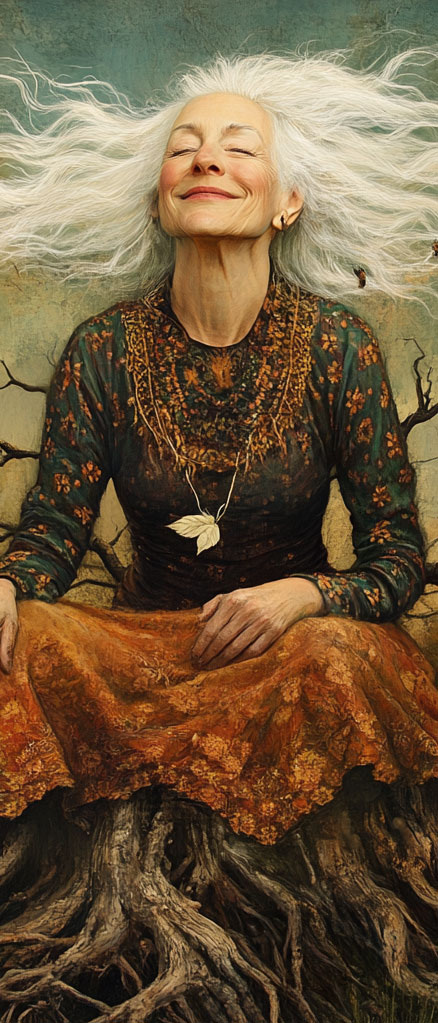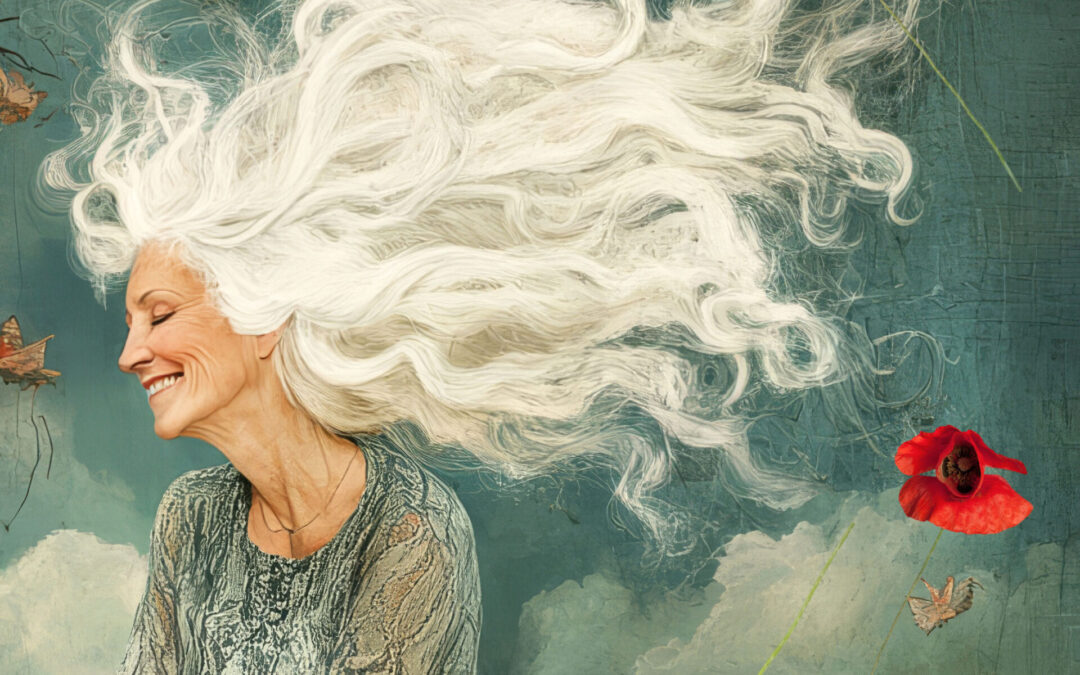Aging – for many women it remains a quiet taboo, a process few dare to speak of.
In a society that worships youth and perfection, maturity is often told as a story of loss – something to correct, conceal, or defeat. Yet aging is not a downfall, but a transformation: an invitation to enter one’s own depth.
As a psychotherapist, I see how deeply these transitions move women – including myself – physically, emotionally, and spiritually. In every fiber, the body calls for relationship, for attention, for a new and tender dialogue. Aging reveals what has long been ignored: needs, boundaries, vulnerability – but also wisdom, self-knowledge, and dignity.
As an artist, I explore this transformation through images. In my collages, bodies, symbols, and inner landscapes merge – telling stories of transformation, of the beauty of ripening, of the courage to remain visible.
For me, aging has become a creative process: a shedding of old skins, a listening to what remains when there is no longer the need to impress. A becoming – in the midst of passing.

There is the shock – almost a betrayal.
My body, once so loyal, so alive – the body that carried me, danced wildly, healed without question – now lies still more often. It no longer sets itself right. It asks for my attention. It speaks through a burning heel, through a hip that will not rest, through a fatigue that lingers like a shadow.
This is my encounter with a new dimension of being.
No longer the whirling dance of before, but a quiet pas de deux with impermanence.
I used to recover quickly – a week, and all was well again.
I was the self-reliant woman – strong, unbending, always ready to swing the sword, no matter how heavy the blade. It worked – magnificently, for a long time.
But now, things are different.
An infection that lingers for months, a heel that still burns, a hip that speaks to me each night.
It is as if my body is whispering the truth of finitude into my ear – persistent, unrelenting, and utterly clear.
The First Awakening
At first, there was shock — and then frustration.
The quiet outrage of realizing that my body, once so reliable, no longer obeys my familiar rhythm.
The “as before” no longer returns on command.
For decades, I could trust it to recover within days, to find its own alignment, to dance me through whatever came. But this year, the body speaks a different language.
It no longer self-corrects. It demands conversation, attention, tenderness — on its own mysterious terms.
Aging comes with its own agenda:
💧 The loss of elasticity — joints whisper, fascia pull tight, healing lingers.
💧 The silence of hormones — the gentle protection of estrogen has faded, and with it a youthful ease in skin, bone, and metabolism.
💧 The fragility of sleep — nights where body and mind call out instead of resting.
And through all this I begin to understand:
It is not about reclaiming the body I once had.
It is about receiving the one I have now.
This requires a new choreography:
💧 Instead of demanding, I learn to listen.
💧 Instead of striving, I practice slowing down.
💧 Instead of pushing through, I begin to soften — with small rituals, warm water, gentle movement, the kind of care that feels like prayer.
It is not easy.
There are days when the resistance is loud, when the memory of my old vitality stings.
But beneath the frustration, something else begins to stir — a quieter strength, born of surrender rather than control.
The Mirror of Society
We live in a culture that worships youth and smoothness,
that tells women their worth fades as their faces deepen and their bodies change.
But alongside this noise, another image is emerging —
a quiet revolution of women who meet their physical ripening with presence, not denial.
Where are our role models?
Perhaps they are already among us —
women who do not retreat into invisibility but step forward differently,
wearing their years as a mantle of truth rather than a disguise.
They move more slowly, yes,
but with the gravity of those who have lived and loved deeply.
They no longer serve the dictatorship of perfection.
They celebrate their bodies not because they are flawless,
but because they are real.
They speak of pain and change, of desire and strength, of joy that has learned endurance.
Finding Words, Building Bridges
To speak of aging — to name what changes — is an act of courage.
Language builds bridges: to ourselves, to one another, to a new kind of wholeness.
In speaking, we become witnesses to our own unfolding.
And so another image of womanhood begins to take shape — one that refuses erasure:
💧 A woman who carries her age openly, without apology.
💧 She wears her lines and her silver hair like a map of her becoming.
💧 Her body no longer rushes to please — it asks to be met.
💧 She does not hide — she transforms.
💧 She does not vanish — she arrives anew.
In a world that worships youth as the ultimate currency,
she embodies another beauty:
the beauty of ripeness, of clarity, of presence that no longer needs to prove itself.
And you — how do you meet your own aging?
I would love to hear your reflections, your stories,
your ways of listening to the changing rhythm of your own body.
